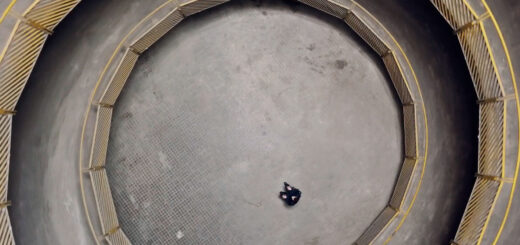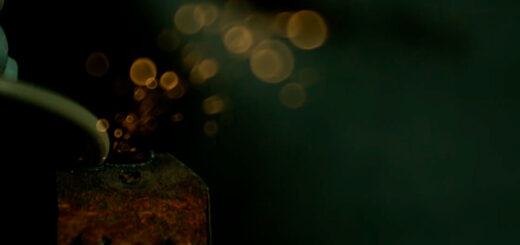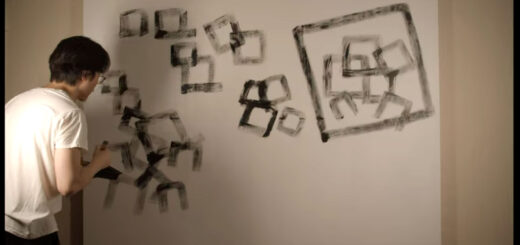Michaela Catranis: DILUVIAN
Beschreibung / Description:
The act of destruction is important to me as a necessary part of the creative process. „To destroy is always the first step in any creation” (E.E. Cummings). In my piece, “DILUVIAN”, for loudspeaker and video, I use an audio-visual process to synesthetically experience the floodwaters of destruction and the aftermath of such an event. It is the prelude to a larger composition about water and the creative process. Within the narrative of this larger work, Diluvian represents what the word indicates: a flood, destruction (diluvian, diluvial – relating to a flood/floods, especially the biblical Flood). We hear the sounds of floodwaters, erratic rhythmic structures and sonorous piano clusters combined with lyrical quotations from another piece I wrote for voice and ensemble, Deux poemès de Nadia Tuéni, about the civil war in Lebanon (vocalisations – JOHANNA VARGAS IREGUI). These quotations strengthen the intensity and programmatic character of the work as a catastrophic event, an event that makes space for something new.
Using a novel audio-visualisation tool developed by robotics and AI scientist, Nikolay Jetchev, we’ve created a visual dimension to this piece by utilising artificial intelligence in the form of adversarial texture generation. The video uses a PSGAN model to generate textures smoothly morphing in time, carefully tuned to the music. Selecting input images with a suitable theme (water) for training the PSGAN allows emphasis on the artists’ vision and represents a novel form of digital synesthesia. A key technical novelty of the method is the use of an audio descriptor of the music instead of a noise prior for the PSGAN, see below for more details.
Technique: texture control
Deep generative models such as the Periodic Spatial Generative Adversarial Network (PSGAN) can learn texture image appearance from data. Image generation with a trained model works by sampling random noise values in a small number array. Given smooth noise changes in time, textures flow into one another in space. The artist can play flexibly with our tool and condition the noise on a moving signal in time, which would then lead to smooth transitions and animations between textures in time. With an appropriate audio descriptor we can map the distribution of audio samples to the distribution of textures. And since music is a smoothly varying signal, we can create an animation frame by frame of a texture process controlled by music. Selecting input images with a suitable theme to train the PSGAN allows us to emphasize the artist’s vision and represents a novel form of digital synesthesia. This tool also opens a totally new pathway for collaboration between musicians and generative model visualizations.
Biografie Autor*in / Biography:
MICHAELA CATRANIS (1985): In ihren Arbeiten setzt sich Michaela Catranis mit den Grenzbereichen zwischen Musik und anderen Disziplinen auseinander, wobei sie Technologie und unterschiedliche Kunstformen nutzt, um ihren akustischen Kern zu erweitern. Musikalisch gesprochen bezieht sie ihre Inspiration aus ihrer klassischen Musikausbildung und aus nicht-klassischen Klängen, die sie auf ihren Reisen und in ihrer Verbindung zur Natur sammelt. Die heimatlichen Klänge und Musiktraditionen, die sie während ihrer Jugend im Libanon und in Ostafrika aufnahm, haben ihre Kompositionsweise stark beeinflusst. Man kann Michaela Catranis‘ Arbeit am besten als poetisch und verstörend zugleich beschreiben; sie verbindet zarte Lyrik und polyphone Texturen mit explosiven, gelegentlich brutalen Hörgesten. Ihre Klangwelt entfaltet sich in lebhaftem Austausch zwischen Disziplinen und unterschiedlichen musikalischen Praktiken, wobei sie zutiefst vom Prozess des kollektiven Kunstschaffens überzeugt ist.
Ihre Werke sind in Konzerthallen wie der Elbphilharmonie Hamburg, der Berliner Philharmonie und dem KKL in Luzern aufgeführt worden. 2018 gewann sie den TONALi18-Kompositionspreis für Jeita, ein Werk für Solocello, und 2019 erhielt sie das Berlin-Stipendium der Contemporary Arts Alliance. Jüngst wurde Michaela Catranis für das Kompositions-Seminar 2019/2020 der Internationalen Ensemble Modern Akademie ausgewählt und für die Académie Voix Nouvelles – Royaumont 2019, in deren Rahmen sie für das Mivos Quartet und Les Métaboles schreibt. Zuletzt erhielt sie auch Kompositionsaufträge von der Fondation Royaument, dem RIOT Ensemble und Zafraan Ensemble.
Sie befürwortet eine ökologisch-bewusste Poetik, ein Konzept, das viele ihrer jüngeren Werke beeinflusst hat, darunter auch the ghosts in these trees, Tierlied/leid.
Michaela Catranis erwarb Abschlüsse als Pianistin (Peabody Conservatory, Hochschule der Künste Bremen) und Komponistin (Hochschule für Musik Hanns Eisler). Sie lebt und arbeitet in Berlin, wo sie auch das interdisziplinäre Performance-Ensemble menajiri gegründet hat.
Interpret*innen und Ort / Interprets and Location:
- Musik – Michaela Catranis
- Stimme – Johanna Vargas
- Visual model – Nikolai Jetchev
- Ort – TONALi SAAL, Hamburg HH





